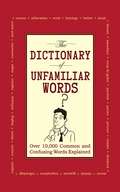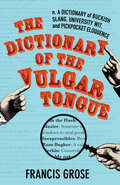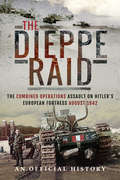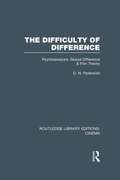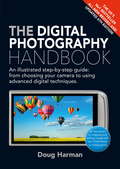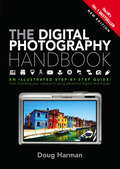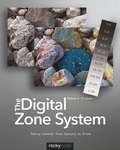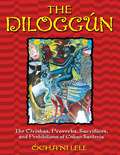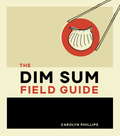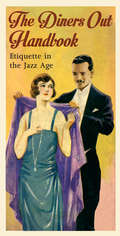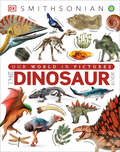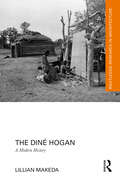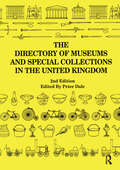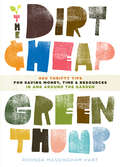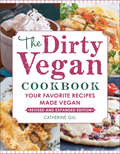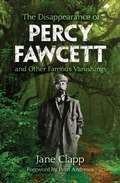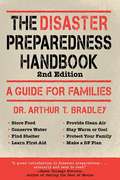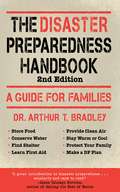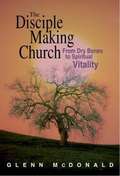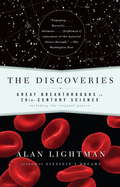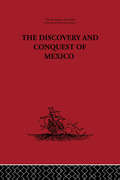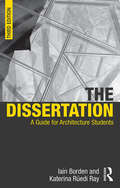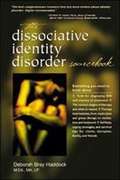- Table View
- List View
The Dictionary of Science for Gardeners: 6000 Scientific Terms Explored and Explained (Science For Gardeners Ser.)
by Michael AllabyA Library Journal Best Reference Pick of 2015! Every gardener is a scientist. Pollination, native plants, ecology, climatology—these are just a few of the scientific concepts that play a key role in a successful garden. While the ideas are intuitive to many gardeners, they are often discussed in unfamiliar scientific terms. The Dictionary of Science for Gardeners is the first of its kind to provide practical scientific descriptions for gardening terms. Highlighting 16 branches of science that are of particular interest to gardeners, with entries from abaptation to zoochory, Michael Allaby explores more than 6,000 terms in one easy-to-use reference.
The Dictionary of Unfamiliar Words: Over 10,000 Common and Confusing Words Explained
by Diagram GroupThis unique reference book strives to define words and phrases that the average person often encounters but which may not be immediately familiar. Batten, kiosk, proctor, coup de grace, alliteration, parsec, corona, renal, joystick, decant, citadel. Broken down into over fifty categories-from cultural essentials likeart, history, and sports to modern obsessions like text messaging and hip hop slang-this book is a word lover's dream and a useful handbook for any student. It covers theatre. It even has a section of foreign words commonly used in English. Expand your vocabulary. Improve your writing. Broaden your horizons!
The Dictionary of the Vulgar Tongue: A Dictionary of Buckish Slang, University Wit, and Pickpocket Eloquence (Hesperus Classics)
by Francis GroseDo you know your abbess from your elbowshaker? Originally printed as a guide to street slang for men of quality, this reference guide will enrich your vocabulary with vulgar witticisms fashionable more than 200 years ago.The avowed purpose of this dictionary was to give men "of fashion" an insight into the inappropriate language of the street. Read in modern times it is by turn uproariously funny and deeply confusing and yet certain truths have remained—the need for the mot juste has not diminished. Many of the words should be brought back into common parlance forthwith: we have no term for the "admiral of the narrow seas," one who from drunkenness vomits into the lap of the person sitting opposite to him. We have perhaps less use for a word for "dobin rig" or "Stealing ribbons from haberdashers early in the morning or late at night; generally practised by women in the disguise of maid servants." Learn how the Georgians and early Victorians would insult each other and find out how some of today's words and derivations have come about in this quirky little volume.
The Dieppe Raid: The Combined Operations Assault on Hitler's European Fortress, August 1942
by UK War OfficeA battle summary of Britain&’s raid on the French port town of Dieppe during World War II. Winston Churchill was under pressure. The Soviets felt that they were fighting the Germans by themselves. Stalin demanded Britain open a second front to draw German forces away from the east. Though the advice Churchill received from his staff was that an invasion of France would not be possible for at least another year, the British Prime Minister knew he had to do something to help the Russians. The result was a large-scale raid upon the port of Dieppe, chosen as it was thought that the success of any invasion would depend on the capture of a major port to enable heavy weapons, vehicles, and reinforcements to be landed in support of the landing forces. It would not be the second front that Stalin wanted, but at least it would demonstrate Britain&’s intent to support the Soviets. Plus, it provided a rehearsal for the eventual invasion. The raid upon Dieppe, Operation Jubilee, was eventually scheduled for 19 August 1942. The assault was the most ambitious Allied attack against the German Channel defenses of the war so far, involving some 6,000 infantry, 237 naval vessels, and seventy-four squadrons of aircraft. Though the debate surrounding Jubilee&’s purpose and cost has raged in the years since the war, many vital and important lessons were learned. All these factors are covered in this official battle summary, a detailed and descriptive account of the Dieppe Raid, which was written shortly after the war and is based on the recollections of those who were involved.
The Difficulty of Difference: Psychoanalysis, Sexual Difference and Film Theory (Routledge Library Editions: Cinema)
by D. N. RodowickThis book argues that serious misreadings of Freud and Lacan on sexual difference have characterized prevailing models of psychoanalytic film criticism. In critiquing theories of identification and female spectatorship, the author maintains that early film theorists and feminist critics are equally guilty of imposing a binary conception of sexual difference on Freud’s thought. By embracing such a rigid definition of male/female difference, they fail to understand the fundamentally complex and fluid process of sexual identification as it is articulated in Freud’s writing, constructed in film texts, and negotiated by spectators. The book turns to Freud’s work on fantasy to develop an alternative model for interpreting sexuality in the visual and narrative arts, one that emphasizes a ‘politics of critical reading’ over accepted theories of ideological identification. Originally published in 1991, its strategic focus on psychoanalysis itself as an object of historical and critical inquiry, and not simply as a reading method is the unique quality of this book.
The Digital Photography Handbook: An Illustrated Step-by-step Guide
by Doug HarmanNeed to know which digital camera to buy? Want to take better photographs and retouch images? Ready to achieve professional results? This updated edition of The Digital Photography Handbook will allow you to make the most of all the advantages your camera has to offer - as well as guiding you through the latest software to enhance your images, and get professional results with every shot. This book includes expert advice on the art of photography (composition, depth of field and how to photograph a variety of subjects), editing and image manipulation software, how to print your images for the best results, developing a portfolio and mastering the rules of copyright. Doug Harman includes the very latest developments in digital technology, equipping you with everything you need to become a photographer. Contents include: Types of camera, Computers and software, Memory, Pixels and magnification, Saving images, Exposure, Composition, Light, Camera modes, Special effects, Manipulating images, Photo apps, Retouching old photos, Printing digital images, Selecting printers and paper, Archiving and the cloud, Making money from your images, Copyright rules and more.
The Digital Photography Handbook: An Illustrated Step-by-step Guide
by Doug HarmanNeed to know which digital camera to buy? Want to take better photographs and retouch images? Ready to achieve professional results? This updated edition of The Digital Photography Handbook will allow you to make the most of all the advantages your camera has to offer - as well as guiding you through the latest software to enhance your images, and get professional results with every shot. This book includes expert advice on the art of photography (composition, depth of field and how to photograph a variety of subjects), editing and image manipulation software, how to print your images for the best results, developing a portfolio and mastering the rules of copyright. Doug Harman includes the very latest developments in digital technology, equipping you with everything you need to become a photographer. Contents include: Types of camera, Computers and software, Memory, Pixels and magnification, Saving images, Exposure, Composition, Light, Camera modes, Special effects, Manipulating images, Photo apps, Retouching old photos, Printing digital images, Selecting printers and paper, Archiving and the cloud, Making money from your images, Copyright rules and more.
The Digital Zone System: Taking Control from Capture to Print
by Robert FisherThere is an ongoing debate among photographers whether digital photography processes will ever be able to reach the pinnacle of image quality and tonality achieved by Ansel Adams decades ago. The Digital Zone System (DZS) is an innovative methodology for editing digital images that mimics the Zone System created by Adams. With this book, author Robert Fisher presents a practical guide for editing digital images with a level of control previously unattainable without significant manual work. He walks the reader through the background of Adam's original Zone System and points out similarities to current digital processes including Expose to the Right (ETTR) and high dynamic range imaging (HDRI). Learn to use luminance masks to separate an image into "one-stop" zones of brightness, similar to the zones in Adams's Zone System, that can be worked on individually or in groups. This makes the DZS a powerful tool for converting color images to black and white. You will also gain tremendous control over how color is adjusted in your images by learning to isolate and adjust color in specific targeted areas. These DZS processes are quicker and simpler than the tedious work of using global adjustments and painting in layer masks to isolate the effects of an adjustment layer. In this book, you will learn how to use the Digital Zone System for editing color images, converting images to black and white, and tone mapping HDR images. Also included are brief discussions of color management, setting up Photoshop, printing, and exposure for digital images. The book is richly illustrated with step-by-step screenshots and stunning example images that show the benefits of the Digital Zone System over commonly used digital editing methods. Once mastered, the DZS will allow you to produce a higher level of quality in your images, at a faster pace and with greater ease than ever before.
The Diloggún: The Orishas, Proverbs, Sacrifices, and Prohibitions of Cuban Santería
by Ócha'Ni LeleThe first book on Santería’s holiest divination system to thoroughly explore each family of odu and how their actions and reactions affect the spiritual development of the client. • Includes the major considerations for sacrifice, providing the diviner with ways to placate and supplicate the Afro-Cuban deities known as orishas. • Demonstrates how to properly end a reading so that negative vibrations are fully removed from the diviner's home. • Provides a thoroughly detailed description of each of the 12 families of odu that exist in the diloggun--from Okana through Ejila Shebora. The diloggun is more than a tool of divination. It is a powerful transformational process, and the forces that are set in motion when it is cast determine the future evolution of the adherent. The Diloggun is the first book to explore this Afro-Cuban oracle from the perspective of diaspora orisha worship. It is also the first book to explore the lore surrounding this mysterious oracle, which is the living Bible of one of the world's fastest growing faiths. The twelve families of odu that are available to the diviner include 192 omo odu, the children of the odu, and each of these patterns or letters has its own proverbs, meanings, prohibitions, and sacrifices. Ócha'ni Lele provides the secret but essential information that the adept diviner needs to know to ensure that every element affecting a client's spiritual development is taken into consideration during a reading. His book is also the first to detail how to properly end a session so that negative vibrations are absorbed by the orishas and fully removed from the diviner's home. For those seeking the wisdom of ancient Africa, The Diloggun is an indispensable guide to the mysteries of the orishas.
The Dim Sum Field Guide: A Taxonomy of Dumplings, Buns, Meats, Sweets, and Other Specialties of the Chinese Teahouse
by Carolyn PhillipsA whimsically illustrated yet authoritative guide to the "taxonomy" of dim sum, based on a popular Lucky Peach story.Author and illustrator Carolyn Phillips demystifies the rich, nuanced culinary institution of teahouse snacks in The Dim Sum Field Guide, a pocket-size, definitive resource featuring 80 hand-drawn illustrations. With entries for all the dim sum classics--including siu mai, xiaolongbao, char siu, roast duck, and even sweets like milk tarts and black sesame rolls--this handy reference is perfect for bringing on-the-go to your next dim sum outing. Armchair travelers and Asian food enthusiasts alike will be delighted by this detailed yet accessible look at the distinctly Chinese art of eating well.
The Diners Out Handbook
by Alfred MilesThis charming pocket handbook is a complete guide to the manners, customs and etiquette of the glamorous 1920s. Each chapter gives detailed instructions for a specific type of social event: what to expect, how to dress, suggested yarns for the raconteur and instructions for deft, witty self-expression. As lively and amusing as it is useful, this is a vintage reproduction of a Gatsby-era pocket guide to courtesy, style and elegance in the age that redefined them.
The Dinosaur Book (DK Our World in Pictures)
by John Woodward DKPacked with more than 1,000 incredible images and full of fascinating facts, this beautiful children&’s encyclopedia will bring young readers face to face with some of the most incredible creatures ever to exist!Did you know that archeologists recently discovered the fossils of a 110 million-year-old dinosaur named Nodosaur, as well as some remarkable feathered dinosaurs that were recently unearthed in China? Well, now you do! Explore everything you need to know about dinosaurs, pterosaurs, marine reptiles, and mammals in this stunning dinosaur encyclopedia for children aged 9-12. Featuring fossil fragments, full skeletons, and CGI renderings of dinosaurs – from the deadly Tyrannosaurus to the plant-eating Diplodocus, armored fish to giant millipedes and terrifying sharks and so much more, this dazzling dinosaur book is a must-have volume for young dinosaur enthusiasts. Celebrate your child's curiosity as they explore:- Striking and detailed diagrams, drawings and illustrations on every page- A highly visual approach to learning- Ideal combination of colorful diagrams with infographic text boxes- Featuring amazing close-ups and CGI reconstructions of prehistoric scenes.- In association with The Smithsonian InstitutionCovering all forms of prehistoric life, from the first primitive invertebrates to the earliest mammals, this kids dinosaur book provides young readers with essential background information about the geological periods, evolution and extinction, and every aspect of dinosaur science! The striking illustrations, photographs and diagrams featured throughout provide an optimum visual learning experience for both children and adults alike, accompanied by an array of fun facts all about your favorite fierce dinosaurs, and some lesser-known species too. This dinosaur encyclopedia includes at-a-glance panels that provide a quick reference to all the stats, making it an ideal combination of colorful diagrams and infographic text boxes, with easy-to-read accessible text for readers aged 9-12, yet can be enjoyed by the entire family, making this enthralling children&’s encyclopedia a beautiful and educational gift that can be passed down generations.Learn all about the world one picture at a time!If you like Dinosaur Book then why not complete the collection? Part of the highly visual Our World In Pictures series, avid readers can become vehicle virtuosos with Cars, Trains, Ships and Planes, venture on a journey across the globe with Countries, Cultures, People & Places and explore the animal kingdom like never before with The Animal Book.
The Diné Hogan: A Modern History (Routledge Research in Architecture)
by Lillian MakedaOver the course of their history, the Navajo (Diné) have constructed many types of architecture, but during the 20th century, one building emerged to become a powerful and inspiring symbol of tribal culture. This book describes the rise of the octagonal stacked-log hogan as the most important architectural form among the Diné.The Navajo Nation is the largest Indian reservation in the United States and encompasses territory from within Arizona, New Mexico, and Utah, where thousands of Native American homes, called hogans, dot the landscape. Almost all of these buildings are octagonal. Whether built from plywood nailed onto a wood frame or with other kinds of timber construction, octagonal hogans derive from the stacked-log hogan, a form which came to prominence around the middle of the last century. The stacked-log hogan has also influenced public architecture, and virtually every Diné community on the reservation has a school, senior center, office building, or community center that intentionally evokes it. Although the octagon recurs as a theme across the Navajo reservation, the inventiveness of vernacular builders and professional architects alike has produced a wide range of octagonally inspired architecture. Previous publications about Navajo material culture have emphasized weaving and metalwork, overlooking the importance of the tribe’s built environment. But, populated by an array of octagonal public buildings and by the hogan – one of the few Indigenous dwellings still in use during the 21st century – the Navajo Nation maintains a deep connection with tradition. This book describes how the hogan has remained at the center of Diné society and become the basis for the most distinctive Native American landscape in the United States.The Diné Hogan: A Modern History will appeal to scholarly and educated readers interested in Native American history and American architecture. It is also well suited to a broad selection of college courses in American studies, cultural geography, Native American art, and Native American architecture.
The Directory of Museums and Special Collections in the UK
by Peter DaleCompiled with the assistance of the Museums Association, this important directory incorporates over 2,100 museums - almost double the number of inclusions in the 1st edition. It covers all types, including collections of artefacts. The index contains over 3,000 subjects. It is designed particularly to uncover those holdings that are more unusual and less well-known. The directory covers all subjects except living organisms. An indispensable reference source for the library and an ideal companion for researcher or enthusiast alike.
The Dirt-Cheap Green Thumb: 400 Thrifty Tips for Saving Money, Time, and Resources as You Garden
by Rhonda Massingham HartDiscover how frugal gardening can lead to fantastic results! Rhonda Massingham Hart provides practical, time-tested tips that stretch your dollar even as they yield beautiful, bountiful plants. From starting seeds to preserving produce, Hart&’s advice ensures that you won&’t waste time and money while growing your own vegetables, flowers, houseplants, or landscape foliage. Perfect for thrifty gardeners of all levels, The Dirt-Cheap Green Thumb covers everything you want to grow, indoors and out.
The Dirty Guide to Wine: Following Flavor from Ground to Glass
by Alice Feiring Pascaline LepeltierDiscover new favorites by tracing wine back to its roots Still drinking Cabernet after that one bottle you liked five years ago? It can be overwhelming if not intimidating to branch out from your go-to grape, but everyone wants their next wine to be new and exciting. How to choose the right one? Award-winning wine critic Alice Feiring presents an all-new way to look at the world of wine. While grape variety is important, a lot can be learned about wine by looking at the source: the ground in which it grows. A surprising amount of information about a wine’s flavor and composition can be gleaned from a region’s soil, and this guide makes it simple to find the wines you’ll love. Featuring a foreword by Master Sommelier Pascaline Lepeltier, who contributed her vast knowledge throughout the book, The Dirty Guide to Wine organizes wines not by grape, not by region, not by New or Old World, but by soil. If you enjoy a Chardonnay from Burgundy, you might find the same winning qualities in a deep, red Rioja. Feiring also provides a clarifying account of the traditions and techniques of wine-tasting, demystifying the practice and introducing a whole new way to enjoy wine to sommeliers and novice drinkers alike.
The Dirty Vegan Cookbook, Revised Edition: Your Favorite Recipes Made Vegan
by Catherine GillThe Dirty Vegan Cookbook, Revised Edition is the all-in-one vegan-style cookbook that makes eating vegan fun, now expanded with new recipes!The Dirty Vegan Cookbook, Revised Edition lets you prepare delicious vegan cuisine that anyone and everyone can enjoy, and showcases the sheer variety of amazing recipes you can create, all while remaining vegan. For too long, the vegan lifestyle has been seen as limiting--a laundry list of all the things vegans can't or shouldn't have.Providing healthy, vegan alternatives to the sorts of delicious comfort foods that everyone craves, The Dirty Vegan Cookbook makes it easier than ever to live the vegan lifestyle, featuring delicious recipes that use common ingredients available in any grocery store.The Dirty Vegan Cookbook features over 120 rich, indulgent recipes that are sure to delight, including: Artisan Sicilian Pizza, Breakfast Lemon Cheesecake, Baked Macaroni and Cheese, Chocolate Chip Cookies, Gourmet &“Beef&” Stroganoff, Roasted Carrot Tomato Soup, Sausage YUMbo Gumbo, Sweet Potato Shepherd&’s Pie and many more.With simple, delicious recipes, The Dirty Vegan Cookbook is not just for vegans, but is perfect for anyone who wants to prepare nutritious dishes using minimal equipment and processing.Self-styled as "vegan junk food"--healthy vegan food that doesn't skimp on taste--The Dirty Vegan Cookbook is a celebration of all the amazing tastes and dishes available to those on vegan diets.
The Disappearance of Percy Fawcett: And Other Famous Vanishings
by Jane Clapp Evan AndrewsThere is nothing more disconcerting than someone vanishing into thin air. Unanswered questions abound and the mysteries only tend to grow. The Disappearance of Percy Fawcett and Other Famous Vanishings attempts to provide clarity and background on several individuals’ unexplained departures.While looking for his mythical Lost City of Z, Percy Fawcett vanished. Amelia Earhart did the same while circling the earth on her historic flight. Much like these two historical figures, there has been a slew of cases that have never been solved—noted author Ambrose Bierce, Czar Alexander I, Judge Joseph Force Crater, famed adventurer Richard Halliburton, and others who never managed to return from their adventures. This book examines and documents each case in extensive detail, in an attempt to bring together some of the loose ends.History.com writer Evan Andrews provides a detailed foreword to add some contemporary insight into the accounts of the vanished in The Disappearance of Percy Fawcett and Other Famous Vanishings.
The Disaster Preparedness Handbook
by Arthur T. BradleyNinety-nine percent of the time, the world spins like a top, the skies are clear, and your refrigerator is full of good food. But the world is a volatile place--storms rage, fires burn, and diseases spread. No one is ever completely safe. Humans live as part of a very complex ecosystem that is unpredictable and merciless. Could you protect your family in the case of an emergency--domestic or global?The Disaster Preparedness Handbook will help you to establish a practical disaster plan for your entire family (covering all fourteen basic human needs) in case the unpredictable happens. Additional information is also presented for those with special needs, including the elderly and disabled, children, pregnant women, and even pets. Well-researched by an army veteran and current NASA engineer, this is the essential guide every family should have, study, and keep handy, in case the unthinkable should occur.
The Disaster Preparedness Handbook: A Guide for Families
by Arthur T. BradleyNinety-nine percent of the time, the world spins like a top, the skies are clear, and your refrigerator is full of good food. But the world is a volatile place—storms rage, fires burn, and diseases spread. No one is ever completely safe. Humans live as part of a very complex ecosystem that is unpredictable and merciless. Could you protect your family in the case of an emergency—domestic or global?The Disaster Preparedness Handbook will help you to establish a practical disaster plan for your entire family (covering all fourteen basic human needs) in case the unpredictable happens. Additional information is also presented for those with special needs, including the elderly and disabled, children, pregnant women, and even pets. Well-researched by an army veteran and current NASA engineer, this is the essential guide every family should have, study, and keep handy, in case the unthinkable should occur.
The Disciple Making Church: From Dry Bones to Spiritual Vitality
by Glenn McdonaldRevised and expanded edition. Is your church shrinking? Are the same people and programs being run year after year, after year? Are your church members worried about the cash in the plate and not the souls in the pews? Do you want to make a change? This is the book for you. Jesus commands us to go and make disciples of the earth. But how does one do this, and what if you aren't sure what kind of a disciple you might make. McDonald explains the 6 traits of a disciple and the marks of a disciple making church.
The Discoveries: Great Breakthroughs in 20th-Century Science, Including the Original Papers
by Alan LightmanAn extraordinarily accessible, illuminating chronicle of the great moments of scientific discovery in the 20th century, and an exploration into the minds of the remarkable men and women behind them. We know and read the literary masterpieces; how many of us have had the opportunity not only to read but understand the masterpieces of science that describe the very moment of discovery? The last century has seen an explosion of creativity and insight that led to breakthroughs in every field of science: from the theory of relativity to the first quantum model of the atom to the mapping of the structure of DNA, these discoveries profoundly changed how we understand the world and our place in it. Alan Lightman tells the stories of two dozen breakthroughs made by such brilliant scientists as Einstein, Bohr, McClintock and Pauling, among others, drawing on his unique background as a scientist and novelist to reveal the process of scientific discovery at its greatest. He outlines the intellectual and emotional landscape of each discovery, portrays the personalities and human drama of the scientists involved, and explains the significance and impact of the work. Finally, he gives an unprecedented and exhilarating guided tour through each of the original papers.
The Discovery and Conquest of Mexico 1517-1521: Containing A True And Full Account Of The Discovery And Conquest Of Mexico And New Spain
by Bernal Diaz CastilloFirst published in 1928.'Something more than an historical document of the first importance...his narrative is so readable that one's interest and admiration are equally divided between the stupendous events he records and the charming revelations of his own character.' Saturday Review.Four eye-witnesses of the discovery and conquest of Mexico by the Spaniards have left written records, but of these the present volume and the letters of Cortés (Volume 14) are by far the most important.
The Dissertation: A Guide for Architecture Students (Seriously Useful Guides Ser.)
by Iain Borden Katerina Ruedi RayThe Dissertation is one of the most demanding yet potentially most stimulating components of an architectural course. This classic text provides a complete guide to what to do, how to do it, when to do it, and what the major pitfalls are. This is a comprehensive guide to all that an architecture student might need to know about undertaking the dissertation. The book provides a plain guide through the whole process of starting, writing, preparing and submitting a dissertation with minimum stress and frustration. The third edition has been revised throughout to bring the text completely up-to-date for a new generation of students. Crucially, five new and complete dissertations demonstrate and exemplify all the advice and issues raised in the main text. These dissertations are on subjects from the UK, USA, Europe and Asia and offer remarkable insights into how to get it just right.
The Dissociative Identity Disorder Sourcebook (Sourcebooks)
by Deborah HaddockFrom Eve to Sybil to Truddi Chase, the media have long chronicled the lives of people with dissociative identity disorder (DID), formerly known as multiple personality disorder. The Dissociative Identity Disorder Sourcebook serves as a much-needed bridge for communication between the dissociative individual and therapists, family, and friends who also have to learn to deal with the effects of this truly astonishing disorder.

